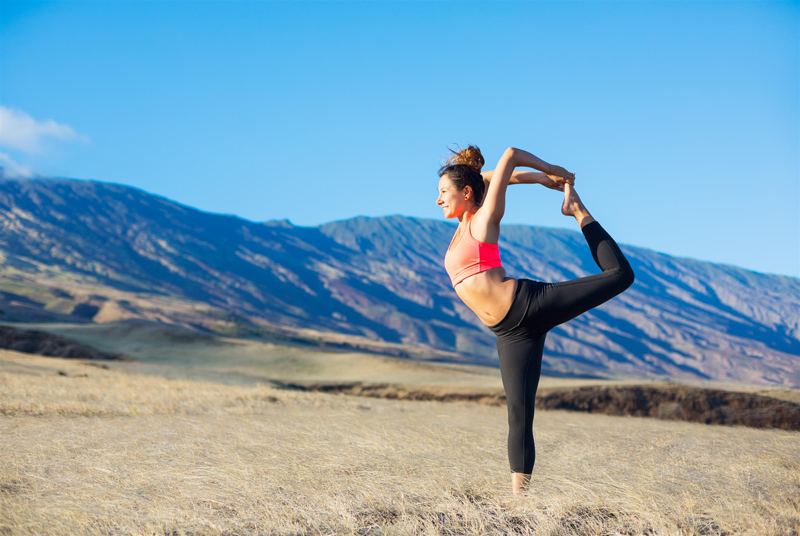
Yoga for a Younger Face
July 5, 2018
What is Chair Yoga?
July 19, 2018Yoga Benefits for Athletes

Today, yoga is used by athletes worldwide. While training in the gym has its benefits, exercise machines often target specific muscle groups and forget about others. Yoga, however, targets the entire body using bodyweight training. Unlike regular weight-training, bodyweight training uses your own weight as resistance; this means that all you need is a yoga mat and some breathable clothes. Creating strong, flexible muscles, yoga helps athletes to avoid injury and speed up recovery time if a strain or sprain does occur. However, this isn’t all yoga can do. In this article, we explore the benefits of yoga for athletes further.
Understand Your Body
Yoga helps athletes to listen to their body. Over time, the practice helps us to become more in tune with our physical and emotional body. This helps athletes to avoid over-working their muscles and know when to give their body a rest. Additionally, athletes can sense when to speed up or work harder, too. Essentially, yoga teaches athletes to listen to their body and understand its cues.
Improved Focus
Yoga also teaches us to focus. During a race, it’s important for athletes to stay in the present moment. Yoga teaches us to concentrate on the present and move forward without distraction.
Increased Strength
As mentioned previously, yoga helps athletes to build all-over strength. While many forms of exercise build strength in just one or two areas, yoga strengthens the entire body. When practiced regularly, yoga can benefit your practice just as much as using the gym.
Relieved Stress
Athletes often suffer from stress and anxiety – especially if they are competing professionally. Thankfully, yoga is a great way to calm the body and mind whenever necessary. Restorative yoga poses can help athletes to wind down after a stressful competition or get some much-needed sleep the night before. Additionally, yoga teaches us how to breathe correctly. Using a deep breathing technique can help to relieve anxiety and stress. Better still, they are simple and subtle so can be practiced anywhere.
Higher Energy Levels
High energy levels are important to any athlete. While there is no magic way to avoid fatigue after a race, yoga can improve blood-flow to keep the body well-oxygenated. Supplying the body with oxygen and nutrients, better blood flow can provide athletes with energy and stamina when they need it most.
Increased Flexibility
To avoid injury, it’s important for athletes to be flexible. Using asanas, yoga stretches the muscles to ensure they are soft, supple, and flexible. Not only will flexible muscles prevent an injury, they will recover quicker if an injury does occur.

Poses for Athletes
Boat Pose
Strengthening the core muscles and the hips, Boat Pose is practiced regularly by athletes. To practice the asana, sit on your mat with your legs stretched out. Rest your hands on the floor behind your hips with your fingers pointing toward your feet. Straighten your arms by pushing your hands into the mat. Next, lean back and lift your feet off the floor. Your back should be kept straight, and your shins should sit parallel to the mat. Finally, raise your arms until they are aligned with your shoulders. You are in Boat Pose. To deepen the stretch, draw your chin into your chest. Hold the asana for 30 seconds whilst breathing deeply.
Cobra Pose
Ideal for increasing flexibility, Cobra Pose is another favorite amongst athletes. To practice the posture, begin by lying on your stomach. Keeping the tops of your feet on the ground, stretch your legs out as much as possible. Place your hands directly under your shoulders and bring your elbows back into your body. Next, straighten both your arms and lift your chest off the ground. Finally, engage your buttocks and press your tailbone into the mat. You are in Cobra Pose. To deepen the stretch, draw your shoulder blades down and back. Hold the posture for around 30 seconds whilst breathing deeply. Once you have finished, release the bend and lower your body back to the mat.
Dolphin Pose
An adaptation of Downward Facing Dog, Dolphin Pose helps to build strength in the upper arms. To prac-tice the asana, start on all fours. Your knees should be directly over your hips and your shoulders should be aligned with your wrists. Keeping everything aligned, lower your torso and rest your forearms on the mat. Keeping your arms on the mat, touch your palms together. Next, curl your toes under and slowly lift your knees away from the floor. Lengthen your tailbone and draw your bottom toward the ceiling. Your body should now form an upside-down ‘V’ shape. While experienced practitioners will be able to keep their legs straight, beginners may find it easier to practice with their knees bent. Finally, press your forearms into the ground and draw your shoulder blades back. You are in Dolphin Pose. To avoid hurting your neck, it’s important to support your head in between your upper arms rather than letting it hand aimlessly. Hold the asana for around 1 minute while breathing deeply.
In Summary
Whether you’re hoping to build all-over body strength or you’re more interested in increasing your flexibility, yoga can help you to achieve your goal. Regardless of your sport, yoga is beneficial to all kinds of athlete – both physically and mentally. If you’re a yoga novice, it may be worth attending a local class. There, a qualified instructor can advise you on the best asanas to use. In your first session, remember to take a fresh bottle of water and a comfortable mat. To ensure you don’t get too hot or cold, it’s a good idea to wear layers. Try wearing a sweater over a lightweight tank top so you can remove it if you become too warm.

